Two of my most favorite restaurants near where I live recently were more or less forced to undergo some major changes, in one place for the better, and in the other, I still not sure. Both are tachinomi-ya (stand and eat and drink) places I have frequented for nearly my entire time in Japan, Edomasa, in Higashinihonbashi, and Shukuzū in Ningyōchō. First, the change for the better:
For the second time in the past seven years or so, Shukuzū (酒喰州) has been forced to change location due to “redevelopment.” Shukuzū is famous for its usually large selection of high-grade sashimi, its tenpura and fried foods, and its offerings of nihonshu. And until it moved to its latest place, hand made soba.
Shukuzū’s original location was in a building that was part of a two story, block-long row of connected businesses in Hizamatsu-chō that had been erected after the war. There was a counter to stand at, a toilet, and an upstairs where the owner lived and made soba. It was a great place for meeting people, and I still have many friends who I first met there. But nothing lasts forever, especially old, somewhat dilapidated buildings in a part of Tokyo that has recently become a very desirable neighborhood to live in. So the shop had to relocate. And it did so to a spot perhaps a thirty-second walk from where I live.
At first the new location was much like the old, only much newer and cleaners. It was still a tachinomi place where customers could eat, drink, and move around to converse. And now there were separate men’s and women’s toilets. The menu was the same, and the regulars were the same. Then the pandemic hit, which cause led to some necessary changes, but not, in my opinion, for the better. Stools were installed for customers to sit on, and plastic screens were installed on the counter between each seat, mostly eliminating the chance to chat. Because I have fairly long legs, when I sat on a stool my body jutted into the walking space behind me, blocking access. And it was not very comfortable. I eventually found one seat and table where I could sit comfortably.
Looking around at all of the old mostly two-story buildings in my neighborhood that have recently been replaced with twelve and thirteen story apartment buildings, I had a feeling Shukuzū’s days at its current location were due to end soon, and I was right. But luckily, after much searching and stress, a new spot was found, and maybe in a slightly better location, in the space formerly occupied by our local Yamato Transport delivery service. But at double the rent!
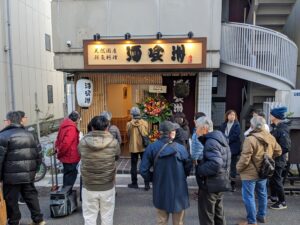
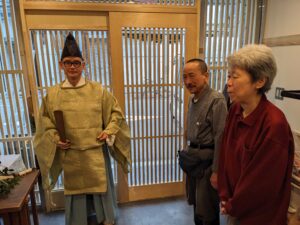
The new place is not stand and eat and drink as it has tables and chairs, as well as some seats at the counter. But the chairs are close enough together to once again be able to meet ad talk with people next to you. Prices have gone up, which is to be expected. But it is still cheaper—and much better—than anything I know of in America.
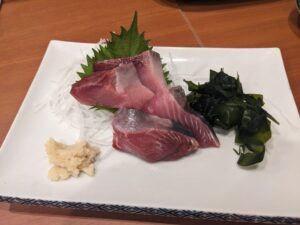
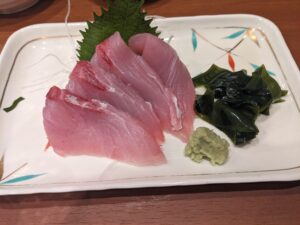
Now to the still undecided place, Edomasa. A yakitori shop I first went to before I had even moved to Japan.
Edomasa is, or at least was, a tachinomi yakitori shop in Higashinihonbashi just in front of Ryōgokubashi, the bridge spanning the Sumida River connecting east and west Tokyo. The business got started in 1924, I believe, as a food cart that would go to sumo heya (houses) and grill chicken for the sumo wrestlers (there is a connection between the two, but this is not the place to get into it). Eventually another business provided the funding for a proper restaurant, which is where the current version still resides, with living space for the family on the floors above. Edomasa was famous for its “nama,” which was raw minced chicken covered with tare (ta-ray, a shōyu-based sauce). Some people and magazines considered Edomasa to serve the best traditional yakitori in Tokyo, if not all of Japan. And then it all came to a screaming stop.
In the fall of 2022, I believe, a scandal erupted after someone posted photos and comments about the raw chicken at Edomasa being “too pink” and not cooked. There was no evidence linking the poster to Edomasa in any way at all, no proof of anyone getting sick from the chicken or if the poster had even ever been to the restaurant. But the outcry was too much so, just short of its 100th year, Edomasa was forced to shut down, eventually going so far as to remove all of the kitchen equipment except for the custom-built gas grill. A while later Edomasa did reopen, but in San Francisco, and it being America, of course without any raw chicken on the menu.
Then last year in September I heard that the restaurant was going to be reopening soon. I asked a few people that would know more about it if it was true, and it was. But there would be a new name, Edo-ryū (江戸柳), ryū being one reading of Yanagi (willow), the name a nod to the nearby Yanagibashi bridge. I couldn’t wait to eat the nama again, and as well as skewers of yakitori. I stopped by to chat with the owner a couple of times before they were open, and noticed some big changes in the décor. Gone were the old sumo stuff, the sumo calendar, the hand prints, and the old banzuke (listing of all the sumo wrestlers by rank). And the original cart that had served as part of the counter was gone as well. Hmmm, I thought to myself. I guess I will need to wait and see.
Finally, the evening of the new opening arrived. And like many times in the past, I needed to wait in line outside to get a spot to eat. Luckily, it didn’t take too long. I was surprised there was a line, until I got inside and noticed only eight customers at a time could fit into the newly reconfigured design. Then I noticed there was no longer any nama, which wasn’t a big surprise. What was a surprise was that there wasn’t any traditional yakitori. Nothing on skewers, except for unagi, which was a good surprise. There was still the tataki (grilled patties of minced chicken) as well as the piiman (bell peppers stuffed with minced chicken). But the main choices for grilled chicken were now momo (thigh) and mune (breast), both big pieces of meat and for the momo, bone, both served on a small plate. And now there is a chicken soup as well. Not just any chicken soup, but more of a “pottage,” a soup made from simmering whole chickens into a very thick and rich liquid. Drinks are still done as before, paid for upon ordering. And now there are some more high-end choices for sake than before.
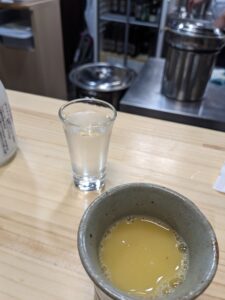
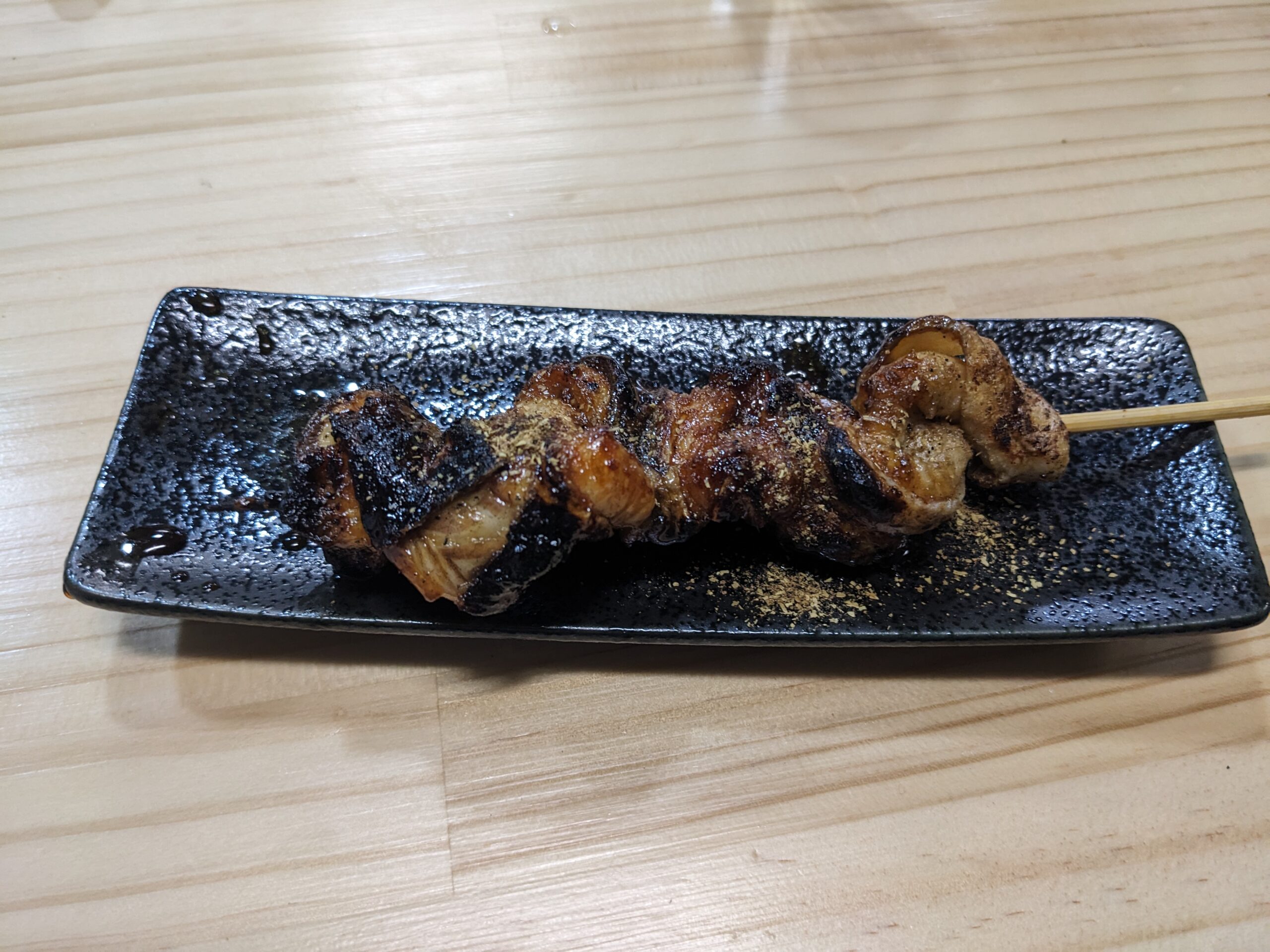
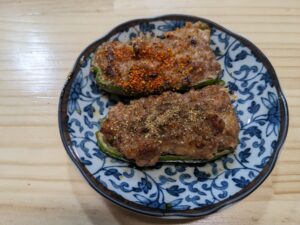
One big difference between the new and old restaurant is how the meat is flavored. Before everything came with the tare and either wasabi (made from powder, not freshly grated) or shichimintōgarashi (seven spice mix). Now the momo and mune are seasoned with an original mix of salt and other ingredients, this new concoction greatly influenced by the chef’s time in San Francisco where he was exposed to the foods and flavors of Mexico, Guatemala, Myanmar, and other cuisines not found in Nihonbashi.
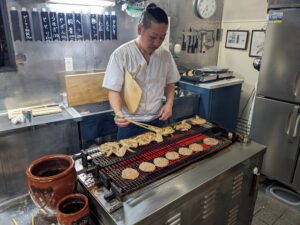
All in all, I am glad Edomasa, I mean Edoryū, is back in business. It is a bit more “classy” now, if a tachinomi place can be considered “classy.” Gone are the trappings of the former place, now replaced with a cleaner look and less eating skewers with your finger. The tare is still young and the flavors not fully developed, but it will start to mature in a year or two. And it is quite a bit more expensive than before, more like ¥3,500 for me compared to half that in the past (the bill for a sumo friend I recently went with came to something like ¥9,000, but he did literally eat at least one of everything on the menu!). But then again, pretty much all food in Japan is more expensive now than a couple of years ago. That’s just how it goes.